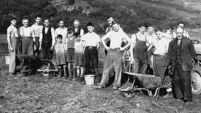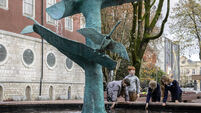John Arnold: My link to a Cork music star - and a GAA story for the ages

Take last Tuesday for example!
A good few years back, when I wrote my first article for the then , the subject I discussed was dung! Yes, that’s right - as a farmer I was very familiar with the topic so no research was really necessary.
A mixture of the waste produced by cattle, sheep and pigs when mixed with straw as a kind of animal bedding, dung is unusual in so far that it’s an item to be got rid of – but has a great value also.
Call it dung or manure, but it’s the oldest yet newest secret of nature.
Grass is consumed by animals to produce milk or beef - depending on the nature of the beast. As they say, what goes up must come down and what goes in must come out, so the by-product of grass, hay, and silage is what we call dung.
Spread it on the land and it fertilises the soil and gets the grass growing once more - pure dung, pure magic!
Then, in an old-fashioned manner, I took my four-prong pike and spread the dung on the bare surface of the field before the heavy showers came.
I’d the job done in an hour - knowing the coming moisture would help soften and break down the dung. Such organic material is great nourishment for the soil.
Years back, such work was a huge part of farm spring work. Dung was vital both for grass growth but also for crops such as potatoes and turnips. Nowadays, most dung is in liquid or slurry form and spread with tractors and tankers.
My sojourn on Tuesday morning was a reminder of how things were done long ago.
It was a drizzly start to the day so birdsong was scarce – the singing birds being smarter than me, staying in the shelter of their nests. I had my little radio in my shirt pocket - I know, I know, I’m addicted to that same radio, but God knows, it could be worse!
As I worked and listened, a song was played by the rising Irish group Kingfishr. Formed by three students, Eoghan, Edmond and Eoin, whilst the trio were studying in UL, they are on the road a few years but have just leapt up the rankings with their own songs, written, released, and flying, and huge tours planned.
Just lately, I discovered that the Eoin in Kingfishr is Eoin Fitzgibbon from Killeagh here in East Cork. His grandparents Tom and Maureen were great friends of mine, through the GAA, and also through their dedication to voluntary work in Lourdes.
In 2007, when I went to Lourdes after a ‘sabbatical’ of 36 years, it was Tom Fitzgibbon said to me: ‘John, you’ll love this place and come back again’, how right he was – they were grand people.
Eoin’s other grandmother, Rose Millerick, I knew too - her first cousin is married to my uncle -circles within circles.
During the radio programme, Colm Ó Mongáin came on - he was presenting show on Tuesday afternoon. Naturally, after the death of Pope Francis, he was anxious to talk to listeners about the late pontiff.
I remembered that 20 years ago, in April, 2005, we were on a visit to Rome. Obviously, we had arranged and booked the trip maybe in January, just after Christmas.
We were back in Rome last autumn - it is well named as the Eternal City.
Anyway, on Tuesday Colm Ó Mongáin was looking for listeners to call in with stories and memories. He gave his email address, phone number, Facebook, LinkedIn, and X contacts - the presenter laughed at the multiplicity of contacts, saying ‘What about carrier pigeon?’
Well, I once heard Tim Riordan talking about the use of carrier pigeons long ago. Tim was born in 1898 in the townland of Glenagoul in Kildinan in Rathcormac parish. When he was growing up, Gaelic games were at a low ebb around here and really it wasn’t until the mid-1920s that hurling and football got going again.
Tim played himself and recalled following the Cork teams, particularly the hurlers. Travelling to games was mainly done by train, or by bicycle to more ‘local’ venues.
Tim remembered Cork playing in Dungarvan, Thurles, the Markets Field in Limerick, even in Tralee. It was really a full day out, leaving maybe at 7 or 8 in the morning and often returning home under cover of darkness.
With radio still in its infancy and no other means of communications, Tim Riordan explained fans would take a carrier or homing pigeon to the game - wings tied.
“They’d know who won before they started milking the cows on the Sunday evening,” he said. Once one person knew, neighbours would spread the news.
Tim was a farmer in Glenagoul -sure, ’twas no wonder he loved the game of hurling as it was not far from his ancestral acres that the famous Cork v Tipperary hurling match was played back in 1741, the lore and folk-memory of that contest was handed down from one generation to the next. Tim died in 1983.
Talking of the Munster Championship, I wasn’t in Ennis last Sunday, but the family was well represented at the game. It was in 1972 I attended my first Munster Championship game so it was great to see a grandchild doing the same in 2025.
In ’72, it was drawn match between the Rebels and Tipp, but back then, before the ‘Round Robin’ was invented, we had a replay!
Last Sunday was the best of times and the worst of times from a Cork point of view. Next Sunday, the Premier County hurlers will be back down the road - 284 years after their first game here in Cork. In Páirc Uí Chaoimh, young players will show their skills and prowess in the Primary Game to be played at half-time. A cousin of Tim Riordan’s will proudly wear the Blood and Bandage of Cork. There’s tradition for ye!
So, the rain falls and the grass grows, the songs continue, the Pope is dead - long live the next Pope, the clash of the ash can still be heard - the more things change the more they say the same.







 App?
App?







